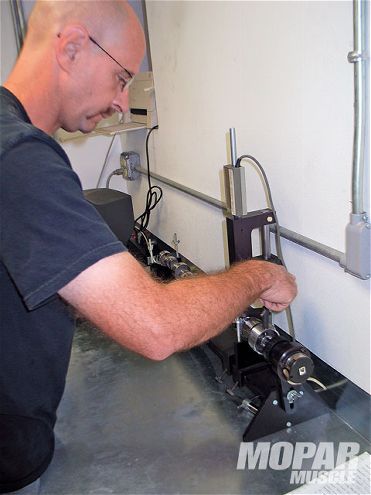
 Whether it's been sitting on our shelves or we acquired it at a swap meet, we've all had a camshaft or two that we just don't know the specs for. Luckily, any machine shop with Cam Pro Plus equipment can check the cam and give you all the numbers.
Whether it's been sitting on our shelves or we acquired it at a swap meet, we've all had a camshaft or two that we just don't know the specs for. Luckily, any machine shop with Cam Pro Plus equipment can check the cam and give you all the numbers.
Over the years, we tend to accumulate a lot of parts for our cars, and often these parts sit forgotten on the shelves of our shops until one day we clean up, wondering what the parts all go to. Some parts, especially engine parts, can be hard to distinguish from each other, so unless the parts are clearly marked it's easy to forget where you got them, and more specifically, what the parts fit. Camshafts are particularly hard to distinguish from each other, as the lobe dimensions can be difficult to measure with normal measuring equipment. Of course it's easy to determine lobe lift with just a set of calipers or micrometer, but the other specifics like duration, duration at .050 inch lift, ramp rate, lobe separation, and lobe centerlines are far more difficult to calculate. Luckily, there's a piece of equipment available at most high-performance machine shops that takes the guesswork out of determining cam specs. The equipment and associated software is called Cam Pro Plus, and we visited our local shop, Auto Performance Engines, to see how it works.
We all have had a camshaft or two that we just don't remember the specifications for because we've either lost the cam card, or the camshaft is not marked with a manufacturer's stamp or part number. But not knowing the specs of a particular camshaft is just one of the reasons Cam Pro Plus equipment can come in handy. Since the equipment can determine cam specifics by simply placing the camshaft in a fixture with sensors, Cam Pro Plus can also be utilized to check a camshaft's runout to see if the cam is bent, or to verify the cam is ground to the specifications printed on the cam card. Additionally, the equipment can simplify camshaft degreeing by telling the user if a camshaft should be retarded or advanced, and by how much, to meet the specs of the card.
Another benefit of using the Cam Pro Plus is that it makes lobe comparison very easy. Especially beneficial when considering reusing a previously run camshaft, this feature allows each lobe to be checked individually and compared to each other for signs of wear. On a new cam, this feature can double check that the cam lobes are not just ground properly, but properly referenced to each other as well. Since the software and equipment can give virtually every dimension of the camshaft and lobes, it can also be used to compare different cams and determine which would best fit your application before installing the cam in the engine. Once the cam lobes are measured, the Cam Pro Plus software can depict the specs numerically or graphically for quick comparison and analysis. Wanting to see how this equipment works, we grabbed a big-block camshaft of unknown origins from our shelves and headed to Auto Performance Engines to watch engine builder Kevin Willis demonstrate how the Cam Pro Plus works.